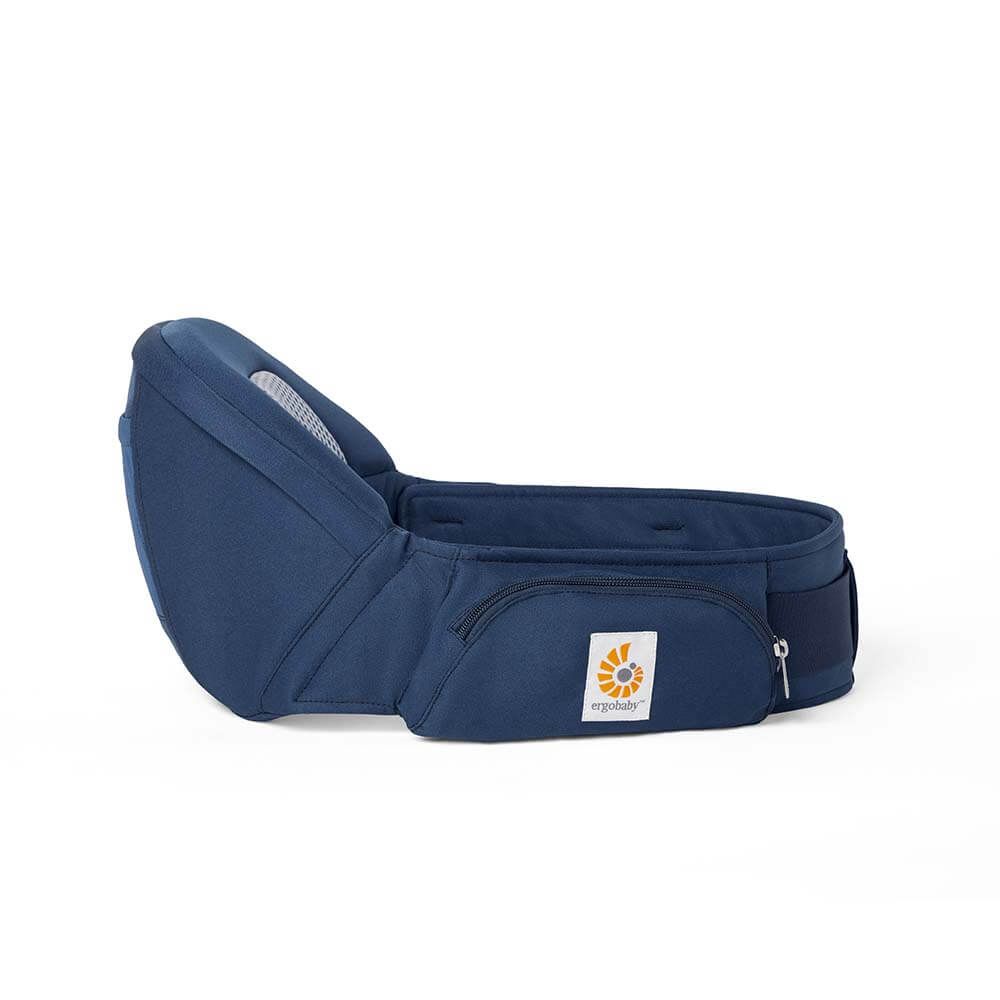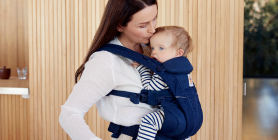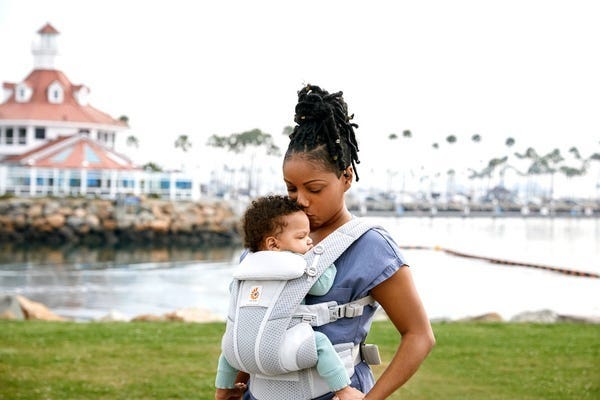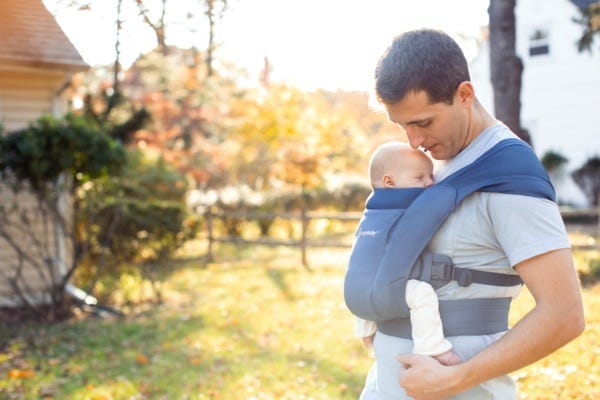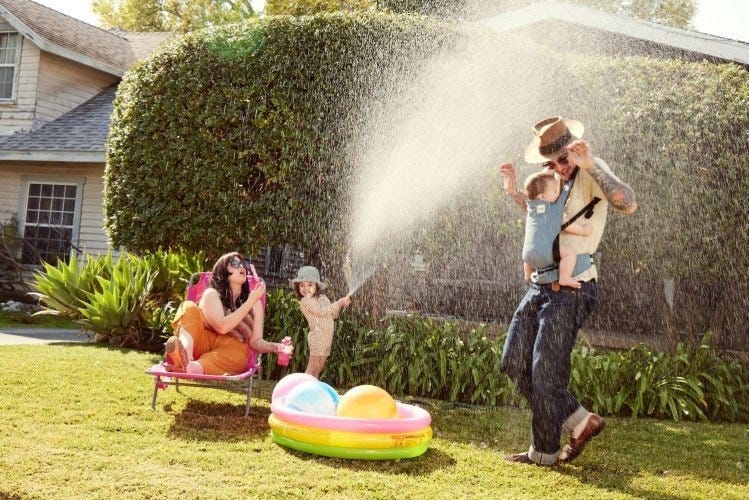Translated from German by Rita Newman, Pediatric neurologist & ERGOparent Expert –
Attachment ”Attachment is a deep and enduring emotional bond that connects one person to another across time and space.“ ~ John Bowlby John Bowlby (1907-1991) a psychiatrist and psychoanalyst living in London, and Mary Ainsworth (1913-1999) are considered to be the pioneers of the attachment theory. According to their extensive research, attachment to a human being or caregiver is the natural need of an infant in which the attachment becomes a safe emotional haven for them. Carrying babies in a wraparound baby carrier or an ergonomic comfort carrier will, for example, assist in the development of secure attachment as it brings the baby in physical contact with its caregiver. The secure attachment Particularly important, for the development of secure attachment, is the appropriate response towards the respective needs of infants. Ainsworth calls these reactions "maternal sensitivity." The following factors assist the secure attachment:
- The extant of maternal sensitivity given by the caregiver in behavior, speech, rhythm, eye contact and touch while interacting with the child.
- The secure attachment provides safety and security for the infant.
- The caregiver must respond to cues given by the infant in a timely and appropriate manner.
The need for attachment is activated by anxiety and separation from the care giver, and then eased again by physical contact. As soon as the attachment need has been eased, the infant can explore its environment freely. Jean Liedloff, a pioneer in the attachment theory, researched the way of life of the Yequana Indians who live in the Venezuelan jungle. The children of the Yequana people are carried around from birth and their upbringing shows a clear sign of secure attachment. The adults live happily and harmonically together, and their children become independent earlier. Parents, who follow their instincts, find out for themselves the right response to their children’s’ needs by picking up the child, carrying it and providing safety and security when the child shows signs of unsettledness. Modern academics like Karl Heinz Brisch have come to the same conclusion as primitive people on this earth: children, who are securely attached from birth, are self-confidant, more resilient, have more sense of accomplishment, show better social skills, enter into relationships and ask for help. They seem to have better memory and show better learning skills. Besides good speech development they seem to feel more empathy. Physical contact will not spoil the child or make it overly dependent on the care giver, but rather prepares the children for independence and self-responsibility (Liedloff). It is therefore not beneficial / wholesome to lay infants in their cradle, and that the care giver leaves the room and let them cry till they are exhausted, like many parents in western societies are advised to do by professionals and parenting help literature. By following these advices parents go against their natural primal instinct and as a result the children experience fear, uncertainty and loneliness which can lead to insecure attachment or even psychopathological attachment patterns. The impact of the separation from caregivers In all recent studies of attachment patterns children have shown stress reactions when they are separated from their caregivers. Reactions like increased heart rate, decreased skin response and higher cortisol levels. Securely attached children will protest a caregiver’s departure. They will call for their caregiver, seek physical contact and can be comforted when picked up. After re-establishing the secure attachment, the physiological stress reactions are eased, whereas in cases of avoidant attachment, pattern or disorganized attachment maximal values of stress are measured and do not decline to normal after the caregivers return. Picking up the child and carrying it is an important part of re-establishing the secure attachment for the child and for the reduction of stress reactions (Brisch). Development of attachment disorder Should a child have a traumatic experience in relation to their caregiver, it may experience the attachment as a risk factor instead of safety. This might in time develop into attachment disorder. Brisch distinguishes two forms of attachment disorders from psychopathological attachment disorder. Insecure attachment
- Avoidant attachment
Children who have developed avoidant attachment because their caregiver showed little or no response to the child’s attachment needs show little effort to maintain contact or avoid their caregiver in emergency situations. These children seem to act cool in situations that should provoke anxious reactions. Should the cortisol levels be measured during the separation of the caregiver they would show maximal stress values. The child has however learned not to show their stress reaction.
- Ambivalent/Resistant attachment
Children who have developed ambivalent/resistant attachment, because their caregiver sometimes responded delicately and sometimes dismissively, react to the departure of their caregiver by crying out and reaching out. At the same time they show aggressive behavior, struggle and kick in the arms of their caregiver. They have already developed ambivalent attachment in the first year of their life. The results of insecure attachment is that the child will be less resilient, have less sense of accomplishment, rather try to solve problems themselves rather than asking for help, enter into fewer relationships, show lesser social skills, have poorer memory and learning skills. Furthermore, the child shows problems with speech development. Disorganized attachment In cases of disorganized attachment the caregiver had mainly shown frightened, frightening, or helpless behavior, and as a result the child shows conflicting behavior patterns between contact, avoidance and disregard towards the caregiver. The result of attachment disorder ranges from loss of emotional security and trust, lack of ability to bond with other people, deficiency in cognitive development, to aggressive behavior in stressful situations or conflicts, and psychosomatic and psychiatric disorders (Brisch). Clinical therapy for attachment disorder In accordance with the German Association for Child and Adolescent Psychiatry and Psychotherapy (der Deutsche Gesellschaft für Kinder- und Jugendpsychiatrie und Psychotherapie), the most important intervention during the treatment of attachment disorder is to find an emotionally available and constant caregiver for the child and create a stabile situation for the development of attachment. In clinical treatment great emphasis is placed on the treatment of attachment disorders. During rehabilitation in a Mother-/Father-Child-Rehabilitation clinic the parents remain the crucial caregivers for their child. If a previous parental trauma causes an inadequate behavior from the parent towards the child, that trauma must be therapeutically treated. The parent’s ability to show empathy and maternal sensitivity has to be trained. With a time-consuming therapeutic intervention, parents can prevent their traumatic experiences from passing on from one generation to the next. Should the parents themselves be receiving clinical treatment, which might demand a lot of their attention, it is possible that another caregiver will be incorporated in the attachment treatment, for example a remedial care worker, psychologist or an educator. They carry the children as needed in a comfort carrier and show affection, are sensitive and available. They must be resilient and emotionally stable to be able to provide a secure haven for the children until the parents are available. Is it possible to treat attachment disorder? An early-originated attachment disorder can be treated even after separation from the caregiver, for example, because of a premature birth, and, subsequently, a stationary treatment in an incubator, or an operation and a long hospital stay. Through intimate interaction with the caregiver a secure attachment can be developed. In that way, an inner connection on a neurobiological level is developed. This way of “relearning” is also possible with older children and adolescents. A basic requirement, for adults to be able to show empathy, is secure attachment, and, according to Liedloff, it is even a requirement for the happiness of our entire community. Carrying an infant and toddlers in a comfort carrier contributes to a child's secure attachment from the beginning. Tips for parents
- Develop your patience and maternal sensitivity as soon as your baby arrives.
- Take time to acknowledge and register your child’s signals.
- Rely on your intuition – you know what your baby needs.
- Show your child affection and gentle physical contact.
- Physical contact with you provides safety and security for your child.
- Choose as often as possible to carry your child around in a wraparound baby carrier or an ergonomic comfort carrier to meet all your child’s needs and development.
- Be genuine about your needs – if you need a break, take turns.
- Take care of yourself as well – when you are doing well, your baby is doing well.
References in German & English: Ainsworth, M. D. S. (1977). Feinfühligkeit versus Unempfindlichkeit gegenüber Signalen des Babys. In: Grossmann, K. E. (Hrsg.) Entwicklung der Lernfähigkeit in der sozialen Umwelt: Geist und Psyche, S. 98-107. München: Kindler. Ainsworth, M. D. S. (1977). Sensitization to your baby’s signals. In: Grossmann, K. E. (Ed.). Early development of learning ability in the social environment: Spirit and mind Bowlby, J. (2006). Bindung. München: Ernst Reinhardt Bowlby, J. (2006). Attachment. München: Ernst Reinhardt. Brisch, K.-H. (2006). Bindungsstörungen - Grundlagen, Diagnostik und Konsequenzen für sozialpäda-gogisches Handeln. In: ArbeitsGemeinschaft für Sozialberatung und Psychotherapie AGSP, Blickpunkt Jugendhilfe, 3/2006. Mohrkirch: Christoph Malter. Brisch, K.-H. (2006). Attachment Disorders – Basics. Diagnostics and consequences of socio-educational therapy. Association for Social Counseling and Psychotherapy, focal point: Child and Youth Services. 3/2006. Mohrkirch: Christoph Malter. Brisch, K.-H. (2009). Bindungsstörungen. Von der Bindungstheorie zur Therapie. Stuttgart: Klett-Cotta. Brisch, K.-H. (2009). Treating Attachment Disorders. From Attachment Theory to Therapy. Stuttgart: Klett-Cotta. Brisch, K.-H. (2011). Bindung und Trauma. Vortrag Kinderklinik und Kinderpoliklinik Dr. von Hauner-schen Kinderspital, Ludwig-Maximilians-Universität München. Brisch, K.-H. (2011). Attachment and Trauma. Presentation in the Paediatric clinic and Paediatric polyclinic of Dr. von Haunerschen Kinderspital at the Ludwig-Maximilians-University München. Dt. Ges. f. Kinder- und Jugendpsychiatrie und Psychotherapie u.a. (Hrsg.). Leitlinien zur Diagnostik und Therapie von psychischen Störungen im Säuglings-, Kindes- und Jugendalter, 3. überarbeitete Auflage 2007, S. 311-317. Köln: Deutscher Ärzte Verlag. The German Association for Children and Youth Psychiotry et al (Ed.). Guidelines to Diagnostics and Therapy of psychological Disorders at Infancy, Childhood and Adolescence. 3rd revised edition 2007, S. 311-317. Köln: German Physicians’ Publications. Liedloff, J. (2009). Auf der Suche nach dem verlorenen Glück. Gegen die Zerstörung unserer Glücks-fähigkeit in der frühen Kindheit. München: C. H. Beck. Liedloff, J. (2009). The Continuum Concept, Perseus.
Emotional Benefits of Getting Outside
Spending time in nature with your baby can strengthen the bond between you. The simple act of holding your baby close, feeling their warmth, and sharing new experiences together can create strong emotional connections. It’s also a wonderful way to reduce stress and improve your mood. When my littles were extra fussy, I’d take a walk around the neighborhood. Even though I don't live in an area with trails and surrounded by nature, simply behind outside changed everything. A little vitamin D does wonders!
Cognitive Development
Nature is a sensory wonderland for babies. The different sights, sounds, and smells can stimulate your baby’s senses and promote cognitive development. Watching leaves rustle, hearing birds chirp, and feeling the texture of a tree bark can all contribute to their learning and development.
All About Baby Carriers for Nature Adventures
Choosing the Right Baby Carrier
When it comes to selecting the best baby carrier for summer adventures, there are several options to consider.
Types of Baby Carriers:
- Wraps: Perfect for newborns, providing a snug and secure fit.
- Slings: Ideal for quick and easy use, offering good ventilation.
- Soft Structured Carriers: Versatile and comfortable for both parent and baby, suitable for longer trips.
Factors to Consider:
- Baby’s Age and Weight: Ensure the carrier is appropriate for your baby’s size and weight. For example, Ergobaby’s Embrace Newborn Carrier is perfect for the fourth trimester where baby is small and you’re looking for an easy way to stay close. As they grow, you’ll want to upgrade to an all-position carrier that’s meant for growing babies.
- Parent’s Comfort and Ergonomics: Look for carriers with padded shoulder straps and lumbar support if you’re planning on longer outings.
- Ease of Use: Choose a carrier that is easy to put on and take off.
- Climate and Breathability: Opt for carriers made of breathable fabrics to keep you and your baby cool in hot weather.
Safety Tips:
- Proper Positioning: Ensure your baby is seated correctly, with their legs in an "M" position and their head should be close enough to kiss.
- Checking for Wear and Tear: Regularly inspect your carrier for any signs of damage.
- Ensuring Adequate Support: Make sure the carrier provides proper support for your baby’s head and neck.
Exploring Nature with a Baby Carrier
Ideal Spots for a Nature Walk with Baby
- Parks and Gardens: Great for leisurely walks and picnics.
- Nature Trails and Forests: Perfect for more adventurous outings.
- Beaches and Lakesides: Wonderful for enjoying the water and sand, with the right carrier.
Activity Ideas
- Hiking: Enjoy a scenic hike with a hiking baby carrier that offers support and storage.
- Bird Watching: Use your carrier to keep your baby close while you explore and observe wildlife.
- Picnics: A carrier can free up your hands, making it easier to carry picnic supplies.
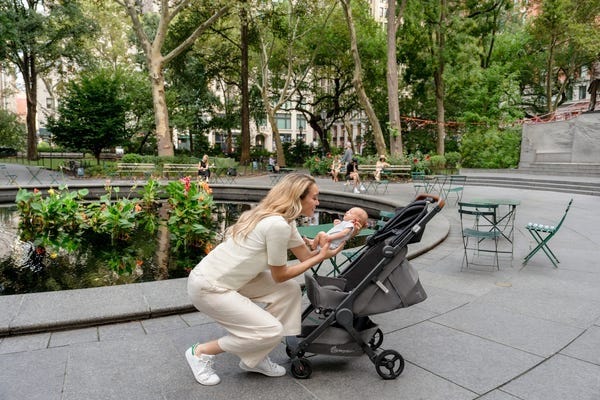

Advantages of Using Strollers for Nature Adventures
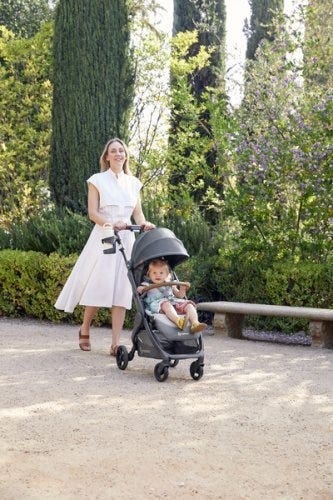

While baby carriers are fantastic for mobility and closeness, depending on the adventure of choice you might want to be a stroller along too.
There are a LOT of baby stroller options on the market. So we understand how confusing it can be to choose the one that’s right for your family. Not only are there a variety of brands, but a variety of strollers that serve different purposes.
There are a few types of strollers on the market:
- Full-sized stroller: This is typically the stroller parents thing of buying for all its versatility.
- Lightweight or umbrella stroller:These compact strollers are perfect for on-the-go adventures.
- Jogging stroller: Designed for parents who want to combine fitness with outdoor adventures.
- Double stroller: Designed for parents with multiple kids, especially twins.
- Car seat carrier: These strollers connect to a specific car seat. We don't typically recommend these as they can be unsafe for baby and uncomfortable for parents who are pushing.
Learn more about the types of strollers and which one would be best for you.
Benefits of Bringing a Stroller
- Storage Space for Gear: Ample room for carrying all your essentials like a diaper bag, beach toys and more.
- Shade and Weather Protection: Built-in canopies to shield your baby from the sun when they are lounging.
- Options: If you have more than one kid, you can stroll with one and carry the other. Or, if you’re getting warm or your little one is getting fussy, you can switch up their position from stroller to carrier or vice versa.
Safety Tips for Strollers
- Ensure your stroller is in good working condition. Make sure buckles are still buckling and that there are no rips or holes that could compromise your baby’s safety.
- Use sunshades or bug nets to protect your little one’s skin.
- Securing the baby properly: always buckle up your baby for safety even if you think they are old enough to go without the buckle.
Combining Baby Carriers and Strollers
For the ultimate flexibility, consider using both a baby carrier and a stroller on your outings.
Combining both options allows you to adapt to different situations. Use the carrier for more rugged trails and switch to the stroller for smoother paths or when your baby needs a nap.
Transition Tips
- Smooth Transitions: Plan stops where you can easily switch from carrier to stroller.
- Pack Light: Only bring essentials to make transitions easier.
Tips for a Successful Adventure
Planning Ahead
- Route Planning: Choose baby-friendly trails and parks. Check local mom groups or outdoor groups and get recommendations for the best outings for kids.
- Check Weather Conditions: Avoid extreme heat or unpredictable weather. Even with our most breathable carriers, when it’s hot, it’s hot. And having two bodies against each other in the heat will be naturally hot and sticky already.
- Packing Checklist: Include diapers, snacks, water, sunscreen, and a first-aid kit. These all-position carriers have storage pockets where you can fit some of the items easily!
- Stay Hydrated and Nourished: Pack healthy snacks to keep energy levels up and bring plenty of water for both you and baby.
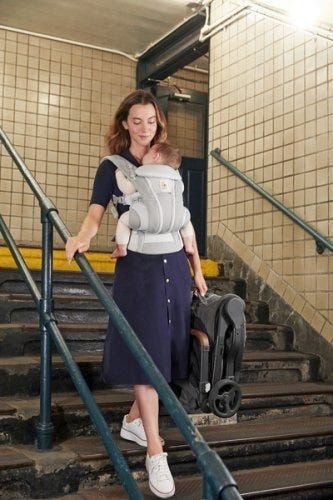

Summer adventures with your baby are a wonderful way to create lasting memories and enjoy the beauty of nature together. From baby carriers to strollers, Ergobaby products are designed to provide comfort and ease for both you and your little one. So, gear up, get outside, and explore the world with your baby by your side.
Ready to embark on your own summer adventures? Check out Ergobaby’s range of baby carriers and strollers to find the perfect match for your family’s needs. Visit our website today and start planning your next outdoor excursion!





